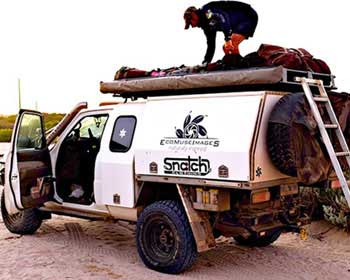Sand Driving in a 4WD
That said, sand driving is where a lot of people make simple mistakes, and it’s also a terrain that works your 4WD very hard. Consider walking along a soft beach; it takes a lot of effort, doesn’t it? Your 4WD feels the same way!
The best tips and tricks for driving on sand
What do you need to know about sand driving?
Let Your Tyres Down
In Western Australia, many of the beaches you can take a 4WD onto are extremely soft. Almost every day someone gets bogged, and more often than not it’s due to tyre pressures.
Tyre pressures are the single most important factor you control as the driver. Get it right, and your 4WD will idle past those struggling to make progress on the beach. Get it wrong, and you’ll be going down faster than you go forwards.
The reason for tyre deflation is simple; to increase the contact patch of tyre touching the ground. If you imagine a tyre that is pumped up to 40 PSI, the sidewalls are tight and there is little bulge. However, let the tyres down to 15 PSI, and the sidewalls bulge out and the surface area touching the ground increases.
The weight of your 4WD is still the same, but now it’s spread over a bigger area, effectively giving you less weight per square cm. A common mistake is to think that your tyre expands in width. It does a very tiny amount, but the biggest gain in footprint is length.
Let your tyres down, and your 4WD will float more easily over the sand instead of sinking like a rock.
Discover the best 4WD tyres for your trip.
What’s The Best Tyre Pressures?
The answer varies from vehicle to vehicle; a lighter vehicle requires lower tyre pressures. That said, a good starting point is 18 PSI for softer sand, and work down from there if required.
You can let your tyres down lower if you are having difficulty moving, but the lower your tyre pressures the easier it is to roll a tyre off the rim. As you lower your tyre pressure, you should be reducing your speed, and cornering much slower.
However, always remember to return to normal pressures when coming back on-road.
Learn more about tyre pressure and how to inflate your tyres.
Engaging 4WD
If you’ve never had your 4WD off-road before, you need to know how to engage 4WD! Most 4WDs these days have automatic locking front hubs, and you just need to select 4WD high and it will do the work for you. If you have a centre differential, lock that too. For those of you who have older 4WDs, you might have to get out of the air conditioning and manually turn the hubs to the 4x4 (or locked) position.Momentum and Gearing
More often than not, when you get stuck in sand it’s when you go to take off again. Maintaining a constant speed through the sand the momentum carries you through any soft sections. On a soft beach, anywhere from 20km/h through to 35km/h is suitable, but adjust it based on how soft it is, the ruts you are in, side angle and other people.It’s important to choose the right gearing too, as this is what plays a huge role in how hard your 4WD is working. If the sand is soft, low range is perfect, using first to forth gear. If your vehicle doesn’t have to work too hard in high range that is fine too, in first and second gear.
Aim to keep the revs in peak performance range, so the vehicle works as easy as possible. Don’t have the revs down too low, or have them up near the rev limiter either; it’s not good for your 4WD, and not necessary either.
Tides
If you are heading to the beach, take 5 minutes to look at what the tides are doing. At the very least, you should know whether they are going out or coming back in. Often the beach will go from two tracks down to only one, or if you are unlucky none; get somewhere only to realise the tide is coming in and you are trapped.Once the salt water hits your car, you are in trouble; it’s hard to get out, and the salt content does serious damage to your panels.
Side Angles
Side angles are a part of driving on the beach, or any sandy surface. While they might not be overly pleasant, take them gently and stick within the ruts where safe to do so.Your 4WD will usually go much further than you are comfortable with, but a bump in the wrong direction can be dangerous and you wouldn’t be the first person to lay their 4WD over.
Clearance
Having adequate clearance under your 4WD is important, and this is where many of the All-wheel drive SUV’s become unstuck. Once you’ve let your tyres down, there isn’t much else you can do to get further on sand. Power is definitely helpful, but not entirely necessary; I’ve driven some pretty gutless 4WD’s on soft sand and never had any issues.If there is room and you are struggling with clearance, you can move out of the main ruts and make your own track.
Where to Drive
If possible, normally staying within the ruts is ideal for sand driving. If you are having issues with clearance you can drive outside of them, but pay particular attention to side angles, and always keep an eye in front of you; beaches can change very quickly.If you come to an edge, slow down and stop until you are happy with it. Dune driving especially can be very dangerous if you just continue driving over the edge.
On a beach, normally the sand closer to the water is harder, but it isn’t always. Stick to the main tracks where possible, and only exit to pass another vehicle or if you are confident the sand is harder elsewhere. Remember, if you do get stuck, the closer you are to the water the faster the tide’s going to get your vehicle!
Sand Recoveries
If you do get stuck on sand, don’t stress; it’s one of the easiest places to get moving again. The first thing to do is stop accelerating if you aren’t moving forward. Get out, check your tyre pressures and deflate them further if possible and spend a couple of minutes on a shovel. Normally from there you can drive out.
Traction aids are fantastic for the sand, as is a gentle snatch strap. In many cases you will have to head downhill a little until you build momentum up again; don’t try and take off up a slope. It won’t happen.
Above all, make sure you take your time with recoveries, especially if snatch straps and winches are involved.
There’s some truly amazing sand driving in Australia, from the many deserts through to endless tracks through the scrub and stunning beaches.
What are you waiting for? See you out there!




